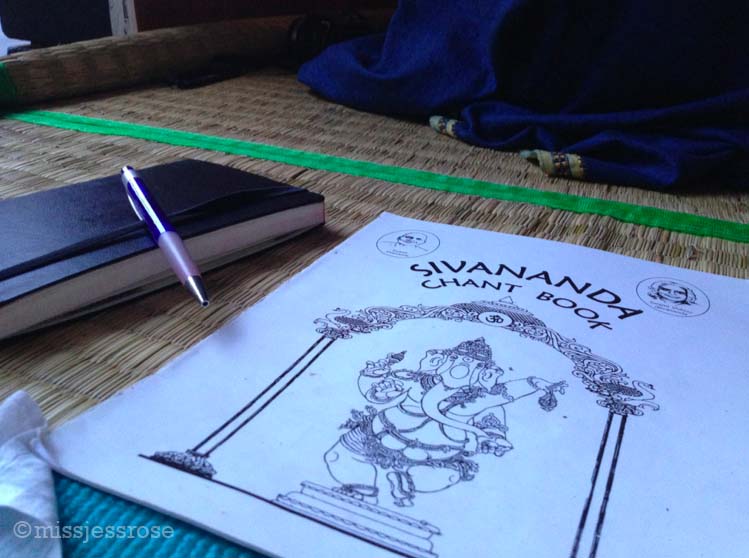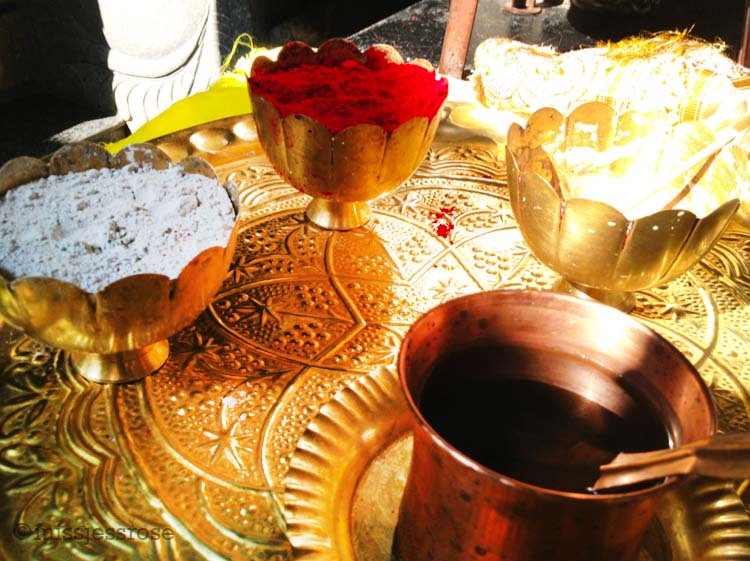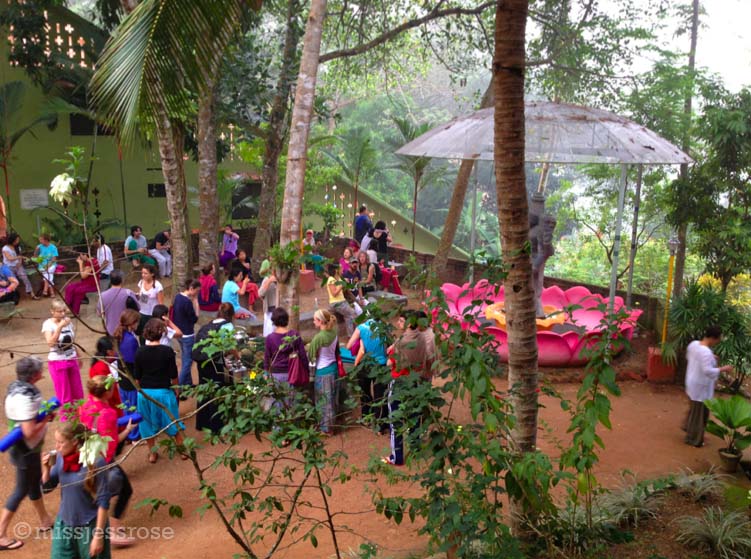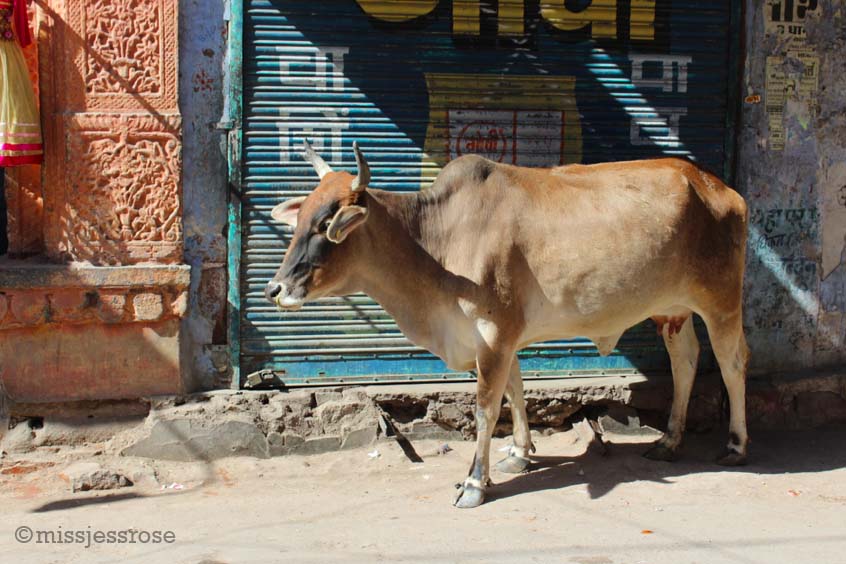My foot is asleep. No, I take that back. My entire leg is asleep. A numb tingling sensation that reminds me of childhood gymnastics shoots upwards through my body. I have been sitting cross-legged in silent meditation, wrapped in the darkness of early morning for satsang (sanskrit for in the company of the "highest truth") since 6:00AM. Given my current inability to feel my legs, I'm not sure things are quite so enlightening right now.
Peaceful Christmas day sunrise over the lake
Dawn is breaking, cool and pastel blue. Somewhere in the distance across the jungle's valley, a relentless tonal recording has been echoing through the treetops for at least an hour. Blaring horns blend with unfamiliar tropical bird squawks and what sounds like a harrumphing call of a hippo, although I'm fairly certain there are no such creatures here. We are in the middle of nowhere tropical India, at a yoga ashram nestled beneath peaceful lush green palms in the Communist state of Kerala.
View of Neyyar Dam across from the Hindu yoga ashram
I feel like a statue in the stillness, a living pillar of non-movement. And it is painful. I wonder if the other 100 or so sitting yogis in the meditation hall feel the same.
Eyes closed, observing my own discomfort, I watch my mind react to the creeping physical numbness that can accompany extended periods of non-movement. Why is it always such a battle to make the unconscious conscious? It is the unconscious that tells me to take immediate action––change position! But it is the conscious––feeble and weak––that is attempting to cultivate the awareness that wills my body to remain immobile in meditation. I try to observe, to ignore my screaming mind, to stay still and wait it out.
Alas, the mind wins this time. I unfurl my legs and stretch.
“Be more meditative. Be more silent. Allow more and more stillness to penetrate you. When your mind is silent, the answer arises from the very depths of your being. ”
Later our teacher's chosen topic of discussion is what he refers to as one of the biggest challenges in life: the mind. Remember, you are not your mind.
The mind can be our best friend or our worst enemy.
It is the mind that tells us never ending stories. It is the mind that expertly weaves a web of judgements, prejudices, and preconceived notions until we're so wrapped up in the rambling narrative echo in our head that we can't help but believe it as truth.
Our teacher says that the practice of yoga polishes our inner mirror allowing us to see the reflection of our true self. In this way, we can better understand the stories of the mind.
This is why yoga is useful: it is a systematized way to "control" the mind through awareness, to find the truth of who you really are by quieting the mind's ceaseless chatter and by finding physical and mental harmony between body and soul. It is an ongoing practice, a constant search to touch what is true.
***
Designs for a puja ceremony on New Year's morning
“An ashram is a Hindu spiritual hermitage, a place of religious retreat that typically focuses on Indian cultural activities including yoga and meditation.”
This is how each day begins at the yoga ashram:
A wake-up bell at 5:30AM before dawn, then almost two hours of required satsang, which includes silent sitting meditation, chanting, and a brief lecture on philosophical topics. Once the sun has risen, we roll up our mats and head to the jungle garden for steaming hot chai tea.
Next it's time for two hours of yoga. All this before eating any sort of meal. (By the way, the food here is nothing to write home about, do not be misled by these special holiday feast photos!)
This pattern repeats itself in reverse in the afternoon and onward into the evening. In between, after lunch, we are obligated to do an hour or two of seva, or volunteer work. It's a good reminder that we are a living part of a larger community.
During the week before New Year's, the ashram adds an annual cultural program to the busy daily schedule. One of my favorite performances is this smiling, head-bobbling old sitar player and his son.
***
Ashram life isn't for everyone, but maybe that's the appeal.
While I feel physically energized after four hours of daily yoga, I admit that at first it's not easy to adjust to such a strict schedule. Sleep deprivation catches up with me quickly here, and the sparse meals trigger a persistent craving for an Indian thali and steaming fresh naan.
Being here requires adapting to less. It's part of the reason so many people come; it's part of a complete meditation. The ashram environment offers space and time to unplug entirely, and unravel mentally and physically.
One of the benefits of all this is that I begin to see things from another perspective. It's amazing how much easier it is to appreciate the basics only after they are taken away. Hot water showers, toilet paper, spoons––in my normal life these things are hardly even noticed. In ashram life, they are greatly missed.
It is here at the ashram that I'm reminded: nothing can exist without its opposite.
There must be a way to balance both absence and presence, to cultivate integration.
“The day is beautiful because there is night.
Life has such joy because there is death.
Love becomes an inner dance because there is hate.
Love leads you to a high peak of consciousness, because love can be lost.
Silence becomes more silent when in the background there is noise.
Don’t try to synthesize the opposite poles of life. Just be integrated. ”
***
It's easy to meet all sorts of the kind of people I want to talk to here––travelers, creatives, seekers of truth. We fall quickly into meaningful conversations.
One night I meet an Australian girl who speaks of the push and pull of relationships. She believes that nowadays people don't stay together very long because in modern relationships, people are rarely in the same place for the same amount of time. It's a tricky balance, she says. We have to be sure to fill our own cup of tea but then just as soon afterwards, fill our partner's. Otherwise life becomes imbalanced, and the partnership misaligned.
I speak with a Swiss artist about what it means to feel alive here at the ashram in a way that isn't possible back home where all that's familiar is taken for granted. Motivation starts to wane, and life seems less fulfilling back there. But here in the ashram, every day feels full of life, even as the rigidity of the daily structure starts to feel the same. Here we are all part of a living moving community, contributing to a bigger whole, breathing and seeking physical and spiritual meaning together.
I think about all these discussions, and the gifts of peace and reflection that are offered here. The trick upon leaving, of course, is learning how to take all that is gained from ashram life and weave it back into hectic real-world life.
Luckily in India, there are no shortages of spiritual reminders.
Small temple adorned with offerings
Holy street cow!






























